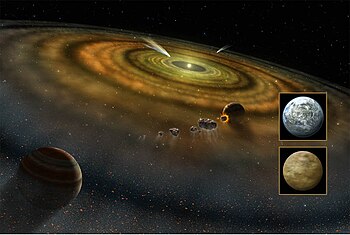Falling Evaporating Body

A exocomet (abgekützt February , English for falling evaporating body ) is in the astronomy an assumed small icy celestial body , popular science Exokomet called (i. E. A comet beyond our solar system ), in the vicinity of a star evaporated .
FEBs are used to explain a random and variable component in the absorption lines of the debris disks around young stars a few million years old. These absorption lines, mostly of simply ionized calcium , are often red-shifted and are temporarily created by gas that is released in the line of sight between the star and the observer.
Falling Evaporating Bodies have so far only been found around young stars of spectral class A, which are often Herbig-Ae / Be stars . This is the result of a selection effect :
- the young A stars develop fast enough to expel the circumstellar gas from the protostar phase via the radiation pressure
- their radiation has the necessary luminosity to vaporize small celestial bodies a few star radii apart, and
- In contrast to the B and O stars, there are many A stars in relative proximity to our solar system.
In the case of older stars, on the other hand, cometary activity drops so much that an accidental discovery becomes unlikely.
The young A-stars show stellar winds with mass loss rates of up to 10 −7 solar masses per year. In order to separate the signal from the Falling Evaporating Bodies from the absorption lines of this strong stellar wind, the FEBs have to release large amounts of gas. Therefore, the diameter of the detectable exocomets is estimated to be up to 100 kilometers, while the comets in the solar system have a maximum diameter of 20 kilometers.
Examples
Falling Evaporating Bodies were detected in the debris from the following stars:
literature
- F. Kiefer et al .: Exocomets in the circumstellar gas disk of HD 172555 . In: Astrophysics. Solar and Stellar Astrophysics . 2014, arxiv : 1401.1365v1 .
- G. Cataldi et al .: Herschel HIFI observations of ionized carbon in the beta Pictoris debris disk . In: Astrophysics. Solar and Stellar Astrophysics . 2013, arxiv : 1312.0924v1 .
- Hervé Beust, Pierre Valiron: High latitude gas in the Beta Pictoris system. A possible origin related to Falling Evaporating Bodies . In: Astrophysics. Solar and Stellar Astrophysics . 2007, arxiv : astro-ph / 0701241v1 .
Web links
- Hundreds of exocomets in a young planetary system @ Spektrum.de, October 22, 2014